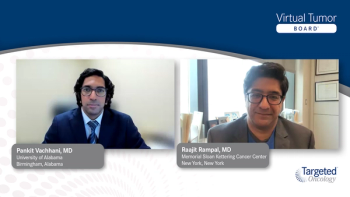
Real-World Use of Lenvatinib + Pembrolizumab in Patients With pMMR Recurrent EC
Expert panelists provide their perspective on the real-world use of combination lenvatinib + pembrolizumab in patients with MMRp recurrent endometrial carcinoma.
Episodes in this series

Transcript:
Robert L. Coleman, MD, FACOG, FACS:Let me start with the top. Dr Birrer, what are your thoughts about the KEYNOTE-775 data?
Michael J. Birrer, MD, PhD:You summarized it great, Rob. That’s a home run. You put it in context for recurrent or advanced-stage endometrial cancer, putting aside the MMR [mismatch repair]–proficient classification. In general, how many prospective randomized trials have we seen where there’s not only a statistically significant PFS [progression-free survival] difference but an OS [overall survival] difference? This is a terrific study, and I credit the designers and the individuals who implemented it. It’s great for our patients. The other element that impressed me—obviously the response rate is terrific, and PFS is fine—is the clinical benefit rate, which was in around 70% for a patient population that usually has metastatic disease. It’s going to progress, and they’re going to feel lousy. I’m very bullish on it. Do you want to save the toxicity discussion?
Robert L. Coleman, MD, FACOG, FACS: I was going to ask the 2 others to weigh in on toxicity. I’ll start with Kimberly. Because you see these patients in the clinic, what’s your impression on patient tolerance?
Kimberly Halla, MSN, FNP-C:It’s all about really giving realistic expectations. You talked about hypertension a lot. Basically, 67% of patients developed hypertension on this regimen. If they come in at grade 1 toxicity, know that if you’re going to advance their medication, maybe add a second medication. Talk about hypothyroidism. Give your patients permission to call. They don’t want to disappoint their providers or their family members. If you give them that ability to call, there are many medications that you can go down. There’s a dose interruption and a dose-reduction schedule. Finding the right dose for them so they can stay on medication longer is best for the patient and overall survival.
Robert L. Coleman, MD, FACOG, FACS: Absolutely. Krishna, what are your thoughts on toxicity? How do you approach the new patient who you see in the clinic with this?
Krishnansu S. Tewari, MD: First, Kimberly nailed it. It’s about managing expectations. I try to share with patients—because they’ve all progressed through chemotherapy—that this isn’t chemotherapy. These are 2 cutting-edge, state-of-the-art medicines. They have adverse effects, but we know how to monitor them. We know how to manage the adverse effects. Dose reductions are probably going to happen. I tell patients that what I’ve seen more than hypertension or hypothyroidism is fatigue. I tell them they’re going to have that, and they need to let us know. Patients don’t want to disappoint us, but we need to know because we want them to feel better. The quality-of-life data and patient experience data from the study were also very favorable, so we want to mirror the results of the study or even do better.
Robert L. Coleman, MD, FACOG, FACS: Agreed.
Michael J. Birrer, MD, PhD:Can I weigh in quickly on that? If you look at the adverse events you showed, about 90% of it is lenvatinib [Lenvima]. I don’t want to point fingers, but that’s what you’re dealing with.
Robert L. Coleman, MD, FACOG, FACS: That’s accusatory.
Michael J. Birrer, MD, PhD:The TKI [tyrosine kinase inhibitor] and I/O [immuno-oncology] drugs we all know and can manage. The other thing that’s interesting is that when I was at MGH [Massachusetts General Hospital], we had a single-agent lenvatinib trial. We went to higher doses, and the most impressive toxicity of the single agent was a complete suppression of appetite and weight loss. I had asked the company to consider this as a weight-loss drug, but they didn’t bite.
Robert L. Coleman, MD, FACOG, FACS: No, because other drugs that are coming out are taking over. I love it. There’s been a lot of discussion about this, and I’m a purist. When we do a study at a dose and schedule that produces results, it makes me nervous to change the dosing schedule and dose and expect to have the same outcomes, even though we know there’s a high rate of dose modifications. I don’t fault them, but many individuals have decided that it’s too toxic on the first dose, on the first course. They want to ameliorate that by starting with a lower dose at the beginning. There has been a lot of discussion about this. There are data that suggest that starting at a subtherapeutic dose might not be good for patients. If you look at those PFS curves, you’ll see that a group of patients go out before the first assessment. The thought is that some of those patients could have been rescued with the appropriate dose. I don’t know. I’m just curious about your thoughts about starting dose at 20 mg with the lenvatinib. Krish, I’ll start with you.
Krishnansu S. Tewari, MD: I contend with this all the time because I have different faculty in our group, and some of them believe starting at 14 mg is better. Our fellows get conditioned that way. They’ll see 1 of my patients and order that, but I try to get them to start at 20 mg. I don’t have any data to support that, but I explain to the patients is that it’s very likely they’ll get reduced. However, there may be something about beginning with a therapeutic loading dose. Then we can go down if we need to. I’m like you: I want to mirror the trial to the extent possible and not make changes unless a regulatory body like the FDA changes the dose.
Robert L. Coleman, MD, FACOG, FACS: Kimberly, what’s your thought on what you’ve seen? You probably even have to deal with the adverse effects a little more because of the callbacks.
Kimberly Halla, MSN, FNP-C:Absolutely. We try to start everybody at 20 mg. I can’t look at a single patient and say, “You’re going to do great at 20 mg,” or “You’re going to do great at 14 mg, but you might do better at 10 mg.” It’s not a weight-based medication like other oral medications we give. We try to give the benefit of 20 mg to everybody. Even if it’s just that loading dose for a few weeks, they get the benefit in the end.
Robert L. Coleman, MD, FACOG, FACS: We have some data on this drug being used across different tumor types. In many of these, not only is the dose different for a starting dose, but some are based on what you just said, weight-based alterations. There’s some customization that we need to do with this. One important feature of Project Optimus that the FDA has been becoming much more stringent about is identifying, from a pharmacokinetic and pharmacodynamic standpoint, that this dose is best used as a starting dose. That way, we get the best opportunity for our patients. But we’ve seen variants across many tumor types.
Transcript edited for clarity.












































